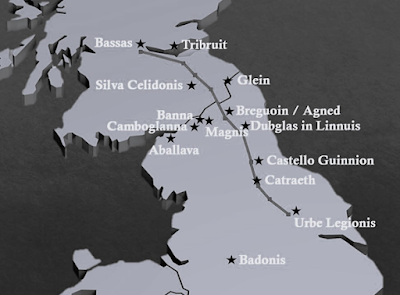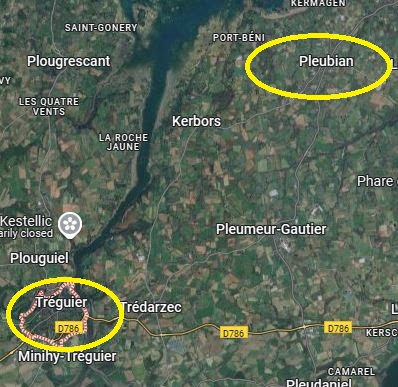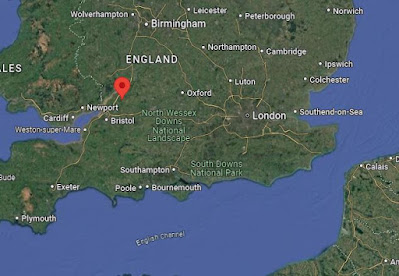Sometimes, when I look for a nice, simple, clean Arthurian theory, I become myopic. And I also tend to relinquish a very good theory in favor of a newer one that I find more exciting. These are errors of methodology that I'm seeking to redress.
I once was certain I had discovered the real Uther Pendragon when I was able to draw a connection between the Pen Kawell of the Uther elegy and Ceawlin of the ANGLO-SAXON CHRONICLE. In brief, Welsh cawell is "basket", as is AS ceawl. As I had long ago proven Ceawlin to be Cunedda "Maqui-Coline", my textual evidence for Cerdic of Wessex/Ceredig son of Cunedda = Arthur accumulated to a satisfying degree.
Why did I move away from a theory that seemed so solid (and even, in some ways, desirable)?
Primarily because while I felt instinctively that the Gewissei battles belonged to Arthur, I had a more attractive and more literally interpreted set of battles for him in the North.
Of course, the whole case for Sawyl collapses if we do one of two things. The first is that we disallow the occurence of Sawyl as a metaphor for Uther in the elegy. Sawyl is, there, an emendation. The text actually has kawyl.
Or we can accept that while Mabon the servant of Uther was present at the Ely River where Illtud was master of soldiers, it does not follow that Uther himself was there. Mabon is in the area because Gileston was originally called the Church of Mabon of the Vale.
What it comes down to is shifting Uther from the Ely River to Nantlle. What does this mean for Uther's historical identity?
Well, Illtud would be out of the picture (as would any attempt to show that the saint had been wrongly identified with Sawyl Benisel). Instead, Cunedda Maqui-Coline/Ceawlin once again comes to the fore.
A standard rule when emending an early Welsh poem like the MARWNAT VTHYR PEN is to make as few alterations as possible in order to achieve good meaning. I once did this with certain critical lines in the elegy.
The important words in the poem that appear to require emendation are here highlighted:
Neu vi luossawc yn trydar:
It is I who commands hosts in battle:
ny pheidwn rwg deu lu heb wyar.
I’d not give up between two forces without bloodshed.
Neu vi a elwir gorlassar:
It’s I who’s styled ‘Armed in Blue’:
vy gwrys bu enuys y’m hescar.
my ferocity snared my enemy.
Neu vi tywyssawc yn tywyll:
It is I who’s a leader in darkness:
a’m rithwy am dwy pen kawell.
Our lord transforms me, Chief kawell.
Neu vi eil kawyl yn ardu:
It is I who's like (or who's a second) kawyl in the gloom:
ny pheidwn heb wyar rwg deu lu.
I’d not give up without bloodshed [the fight] between two forces.
For the GPC attestations of these words and the related cafell, see the NOTE at the bottom of this post.
If we do nothing with kawell at all, then we have pen kawell, which seems ridiculous. It could be kafell, "sanctuary", and so God in the line would be Chief of the Sanctuary. This is certainly possible.
Or we can do as I've already suggested above and allow Chief Basket to stand as a Welsh rendering of Ceawlin/Cunedda.
Kawyl can be given an n (indicated by a mark by a copyist and thus easily omitted) to make it kanwyl[l], a term meaning 'candle' that could also denote a star or a leader. The kawyl line parallels the line above the kawell line, which describes a leader in darkness. So a luminary (or star) leading in the gloom makes the most sense here.
Also, as I've pointed out before, Uther as as a star explains Geoffrey of Monmouth's dragon-comet, which he identifies with Uther himself. Geoffrey also invents Gorlois out of Uther's gorlassar epithet.
These two emendations represent the smallest and simplest changes we can exert upon the text and still yield sensible meaning. More than sensible, really, as we provide an explanation for the Galfridian dragon-comet as a motif deriving ultimately from the elegy itself.
The question is whether we're justified in keeping cawell in preference to cafell.
Well, if I didn't already have a good argument an entire book-length long (THE BEAR KING: ARTHUR AND THE IRISH IN WALES AND SOUTHERN ENGLAND), I would say no. But when my theory for Arthur = Ceredig son of Cunedda/Cerdic of Wessex is carefully considered, the correspondence of cawell and Ceawlin feels positively providential.
But what about the emphasis placed in the tradition on the Cornish Arthur and Uther?
One possibility has to do with archaeology. It is generally believed the English made their way up the Thames Valley before they began infiltrating Hampshire. This is opposite of the ASC testimony, but then again the ASC reverses the early generations of the Gewissei.
If the Thames push was first, and the Gewissei were fighting for the British, not against them, then Durocornovium and Liddington/Badbury and Barbury would have made a good advance base of operations against the invaders.
However, the presence of the grave of Cunorix/Cynric son of Maqui-Coline/Ceawlin at Viroconium/Wroxeter in the heart of the old Cornovii kingdom suggests a more attractive reason for associating Cunedda and his family or teulu/warband with Cornwall. I have theorized that the Gewissei were acting in a federate capacity, holding NW Wales for the high king at Wroxeter in return for military service against the Saxons. In this sense, then, the Gewissei became associated in legend with a "Cornwall." Eliwlad the eagle/grandson of Uther may have been put in Cornwall (although he clearly originates in Nantlle) because he was associated with the Eagle of Eli, a place in the heartland of the old Cornovii kingdom.
What does all this signify, then?
That our best bet for Arthur is Ceredig son of Cunedda, and that his battles are to be identified with battles of the Gewissei.
NOTE:
14g. IGE² 37, Cenglynrhwym bob congl unrhyw, / Cafell aur, cyfa oll yw.
15g. GO xxxii. 29-30, Tai melys win, teml y saint, / Tair kavell, tŷ y’r kwvaint.
15g. DE 119, o gyfarch yn y gafell / i dduw a mair oedd ym well.
1567 LlGG 104a, yn y Gauell [:- gangell] lle bo’r Voreul ar Brydnonawl weddi wedir ordenio i dywedyd.
1632 D, Cafell, Chorus Ecclesiae, Adytum.
1671 C. Edwards: FfDd 212, ymhen isafl cafell Baccus … y mae alior Fenus.
1722 T. Evans: PS 35.
13g. LlDW 1021, [gwerth] kauell teylyau .1.
14g. IGE 214, Balchach wyf gilio’r bolchwydd / O’r cylla rhwth cawell rhwydd (Iorwerth ab y Cyriog).
c. 1400 R 13407, gwamal bwyt gawal. budyr y gawell.
c. 1400 [RB] WM td. 10012-14, nachaf gwr diruawr y veint … yn dyuot y mywn achawell gantaw.
15g. DGG 127, Deuthum a’r cawell trum cau / Ar fy nghefn, oer fy nghofau.
15g. FfBO 48, deu gawell yn llawn o wedilly[on] bordeu.
15g. GGl 98, Mae’n ei gawell facrelliaid.
1547 WS, Panier kawell A pannyer.
1567 LlGG (Sall) 75a, a’ei gawell yn llawn o hanwynt [saethau].
1588 Ecs ii. 3, [c]awell iddo ef o lafrwyn.
1620 Jer v. 27, Fel cawell yn llawn o adar.
1632 D, Cawell, Sporta, corbis, cuna.
1753 TR, cawell … a cradle.
1763 ML ii. 547, Roedd Huw wedi dwyn iddo sachlen o wiail o’m gwig helyg, i wneuthur o honynt gewyll, Ang., baskets, i wragedd y Llannerch.
10g. (Ox 2) VVB 64, cannuill, gl. lichinum vel cantela vel teda.
13g. C 304-6, Kin myned im guerid imiruet. in tywill heb canvill im gorsset.
13g. C 8511, kanuill kangulad.
13g. LlDW 239-13, kanuyllyd … a del[y] pen ekanuylleu a tenh[o] ay ddannet.
14g. T 1517, canhwyll yn tywyll a gerd genhyn.
1346 LlA 39, tebic ynt y gann()yll yn goleuhav y ereill.
14g. WM 12324-6, peredur tec … blodeu y milwyr achanhwyll y marchogyon.
id. 43016-18, gwedy llosgi cannwyll o honei hi yn oleuad itaw ev vrth wiscaw.
14g. GDG 294, Gorffwyll am gannwyll Gwynedd.
c. 1400 R 103229, tec agannwyll pwyll y dyn.
c. 1400 MM 50, Kymryt kanhwyll o wer deueit.
15g. GGl 203, Cannwyll yw’n canu llawer / I beri clod a berw clêr.
1567 TN 104b, Canwyll [:- Goleuad] y corph yw’r llygat.
1588 Diar xiii. 9, cannwyll y drygionus a ddiffoddir.
1595 Egl Ph [ix], Pwy a gymmer arno chwilio’n lwyddiannus yr Arabieit … heb y gannwyll ymma yn gynrithawl o’i blaen?






































